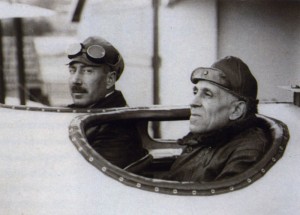Across the South Atlantic in 1922
On this day in 1922, a pair of Portuguese aviators, Sacadura Cabral and Gago Coutinho, set off on the first flight across the southern Atlantic

On this day in 1922, a pair of Portuguese aviators, Sacadura Cabral and Gago Coutinho, set off on the first flight across the southern Atlantic, from Lisbon to Recife, Brazil. They made it, but with plenty of down time for repairs and waiting on replacement aircraft. They finally finished the 5,100-mile voyage at Rio de Janeiro on June 17, after a total of 62 hours flying.
Along the way they lost two airplanes—their original Fairey III D hydroplane, "Lusitania," which sank in the ocean off the tiny rocks of St. Peter and St. Paul, and a second Fairey, "Portugal" which didn't get much farther before it, too, ditched in the sea (the pilots bobbed in the water for hours before being rescued by a passing freighter). The final leg of the trip, from the islands of Fernando Noronha to Brazil, was in a Fairey 17 named "Santa Cruz."
Cabral, a Naval aviator, had been inspired by two Atlantic crossings three years earlier—a U.S. Navy journey from New York to England in a Curtiss NC-4 flying boat, and John Alcock and Arthur Brown's first non-stop crossing from Newfoundland to Ireland, accomplished in only 16 hours on June 15, 1919.
At Cabral's suggestion, the Portuguese and Brazilian governments started planning a South Atlantic crossing within days of Alcock and Brown's trip. But first, they had to figure out how to navigate to a hard-to-find refueling stop like Fernando Noronha (the biggest island is just six miles long) after crossing 1,450 miles of open ocean. Cabral's friend Gago Coutinho, a Naval commander and cartographer, developed a new kind of sextant that used a water bubble to create an artificial horizon, and it was this use of internal navigation that made the trip possible.
At the time, Charles Lindbergh was 20 years old. And though he probably hadn't heard of Cabral and Coutinho at the time, the man who five years later would make the most famous Atlantic crossing in history took his first airplane ride on April 9, when the Portuguese aviators were already halfway across the ocean.